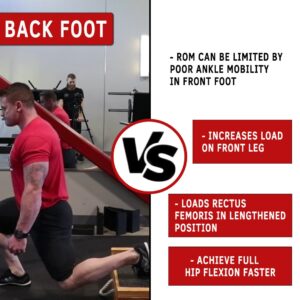Split Squats: FFE VS BFE
n1 training
Introduction
The goal of these “versus” posts is not to say that one exercise is absolutely better than another. Rather, it is to give you some insight in to which exercise might be better suited for a particular situation or for a specific training stimulus.


Programming considerations for the Front Foot Elevated Split Squat (FFE) versus the Back Foot Elevated Split Squat (BFE).
When programming the FFE or BFE Split squat the goal of the exercise must be considered; are you wanting to bias more Glute or are you wanting to bias more Quadriceps.
Both forms of split squats challenge pelvic stability simultaneously in two different directions.
It should be noted; whatever split squat variation you choose keeping your eye on the pelvis position is key. The pelvis should be neutral or slightly forward. Excessive pelvic rotation forward or shifted from side to side becomes a dysfunctional exercise.
The FFE elevation de-loads the front leg; allowing you to adjust making the exercise slightly easier in the lengthened quad position.
The FFE Split Squat can allow those who have long femurs to get more range of motion in the front leg’s hip before the back leg hits the floor.
The FFE Split Squat is not the solution to a “more lengthened quad” it is a solution to de-load the front leg for those who are weak in the lengthened position or those who have long femurs and the back leg hits the floor before the lengthened quad is achieved. It you struggle to get to a lengthened quad position then the heel lift/wedge is a better option.
If you struggle to get to a lengthened quad position and you want to de-load the lengthened quad position, adding a heel lift/wedge to the elevation will help you as well. Although this will affect the amount the Quad is de-loaded in the lengthened position.
The BFE split squat will allow you to load the fully lengthened Rectus Femoris of the back leg.
The BFE split squat will allow the front and back hip (hip flexors and hip extensors) to achieve a greater degree of range of motion.
Both split squat variations can be used for lower rep protocols, but it will be dependent upon the individual’s ability to stabilize the pelvis under heavier loads.
Both split squat variations lend themselves to greater potential for mechanical trauma due to the fact that extreme ranges of motion can be trained and overloaded.
Both variations can fit into a systemic program; but beware of the frequency of the program as mechanical trauma will lead to more time for recovery.
Both the FFE and BFE split squat fit into a hypertrophy program especially when the goal is mechanical damage due to the extreme ranges of motion achieved in the split squat.
When programming either split squat into a workout it is best to have it towards the beginning of the session due to the amount of stability needed in the pelvis. You do not want to go into a hard set of split squat with pre-fatigued pelvic stability.
Importance of Understanding Exercise Selection
videoBody Composition Hypertrophy Program Design Strength & Power TrainingExercise Selection for High Frequency Training
videoBody Composition Hypertrophy Program Design Training
Popular Pages
Learn & Train With Us
Add N1 Training to your Homescreen!

Please log in to access the menu.





